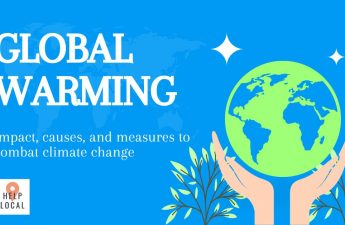We all know plastic is a widely used material in households and industries. Furthermore, the utilization of plastic has experienced an exponential surge since the 1950s, impacting the ecosystem and human societies alike.
According to a report, approximately 12 million tonnes of plastic is dumped into the ocean every year, disrupting the marine ecosystem by killing thousands of fish, and sea birds every year.
On that note, Helplocal-a trusted environmental NGOs discovering platform in India – decided to write an extensive guide explaining everything about plastic pollution ranging from its impact, causes, and tips to reduce the plastic pollution. Read on!
What is Plastic Pollution?
Plastic pollution is an accumulation of synthetic plastic products in the environment to such an extent that it becomes hazardous to wildlife, the ecosystem, and the human population.
According to The World Economic Forum, 32% of the 78 million tons of plastic packaging produced annually is left to flow into our oceans, which is equivalent to pouring one garbage truck of plastic into the ocean every minute.
What are the causes of Plastic Pollution?
While there are many ways that causes plastic pollution, below are the main causes:
Single-use plastic
Single-use plastic items are a common source of plastic pollution. A plastic water bottle, for example, is often used once and then thrown away. This alone creates a huge problem. Once they are no longer usable, they end up in landfills, where they become a source of pollution.
Chemical Processing Facility
Many plastic products are produced in large chemical industries. These factories use complex manufacturing processes that release a variety of harmful substances. Many of these substances are released into the environment when the plants are not properly managed, which can lead to plastic pollution.
Beauty Industry
Products from the beauty industry also contribute to plastic pollution. Indeed, many cosmetics and personal care products are packaged in plastic. These packaging materials are designed for long-term survival so eventually they end up in landfills, resulting in environmental degradation.

Manufacturing Processes
There is no real way to end the inevitable plastic waste that is produced by various manufacturing industries. For instance, many industries produce chemicals and harmful substances, which eventually are hazardous to the environment.
Decomposition time
It takes over 400 years for plastic to decompose, which is a long time for the amount of plastic we want to get rid of.
11 Tips To Reduce Plastic Pollution
Avoid single-use plastic
Single-use plastic is the biggest factor that contributes to plastic pollution. This includes plastic-wrapped vegetables and in supermarkets, wet wipes, cotton buds, plastic cutlery, coffee cups, straws, sanitary products, and cigarettes, which are intended to be used once. All above-mentioned products are used once and thrown away, hence they end up in landfills and take years to decompose.
Using Alternative Packaging Options
If you own a cafe or a small business, you should try to use alternative packaging options, instead of using high-density polyethylene (HDPE), bioplastic should be used that are made from renewable, bio-based materials like cellulose, and the potential to biodegrade more quickly than normal plastics.
Do a trash audit
People should consider doing a trash audit since it will help people to know about the kind of waste they produce. This will also help to know more substitutes for the discarded items. For instance, if we find a lot of crisp packets in our waste, we should consider buying bigger packets that have more sustainable packaging options.
Choose clothes made from sustainable or recycled materials
Many clothes of fashion brands are made from plastics: polyester, nylon, and acrylic. So when masses of clothes go to landfills after being worn, they don’t biodegrade for hundreds of years. Instead, if you want to buy new clothes, continue buying garments made from sustainable or recycled materials, which will help to reduce plastic use.
Stop buying water
When we travel, we always prefer to buy a plastic water bottle whenever we feel thirsty, which eventually ends up creating single-use plastic waste. People should try to consider getting a refillable bottle when they travel.
This little step can prevent the accumulation of plastic, hence preventing plastic pollution.
Avoid Microplastics
Microplastics is a term we use to describe pieces of plastic debris that are less than 5mm in length. They are a big problem, especially in our oceans, as fish will often unknowingly consume microplastics. Hence, the large number of marine animals like turtles, marine mammals, and sea birds die.
Put pressure on manufactures
Governments and manufacturers must make a difference when it comes to plastic usage and waste. Industries should consider using more sustainable packaging material. Moreover, detrimental methods of manufacturing that release a greater amount of pollutants into the environment should be banned.
Recycle

Out of all the plastic that is produced in the world, only about 9% is recycled. This is an extremely low percentage and there is a lot more that needs to be done in this field. In households, water bottles, plastic containers, straws, lids, etc, are common items that are easily recycled. Businesses, on the other hand, should develop methods to recycle and reuse the plastic generated.
Buy in bulk
People always consider purchasing household items or other commodities in small quantities, which requires a large number of packaging materials and containers. One of the better ways to reduce plastic use would be to make bulk purchases of the items that are frequently consumed. Apart from being environmentally conscious, people would also be able to save money by buying in bulk at discounted rates.
Demand Reverse vending machines
Reverse vending machines are machines where people can deposit used plastic bottles and containers for recycling. In every deposit of plastic bottles or containers, people are rewarded with money credits, which eventually encourage recycling. Communities should urge the government to place reverse vending machines on every street.
Organize beach and river clean-up
Removing the harmful plastic waste from the water bodies will not only ensure cleaner water but also safeguard marine life. NGOs and other local organizations often carry out such drives. Approaching various NGOs and charity organizations and showcasing your skills, and volunteer your time can help to reduce plastic pollution.
Reduce Plastic Pollution: Wrapup
Plastic pollution is ubiquitous. A collective effort is required to ensure the reduction of plastic waste. Even if one person decides to end the use of plastic, it can have a great impact.
Environmental sustainability can only be achieved when all the members of the society vow to do their part in preserving natural resources and start opting for sustainable and Zero Waste Products.
Don’t forget to check out our recent blogs and NGOs in India:
NGOs for environmental protection



